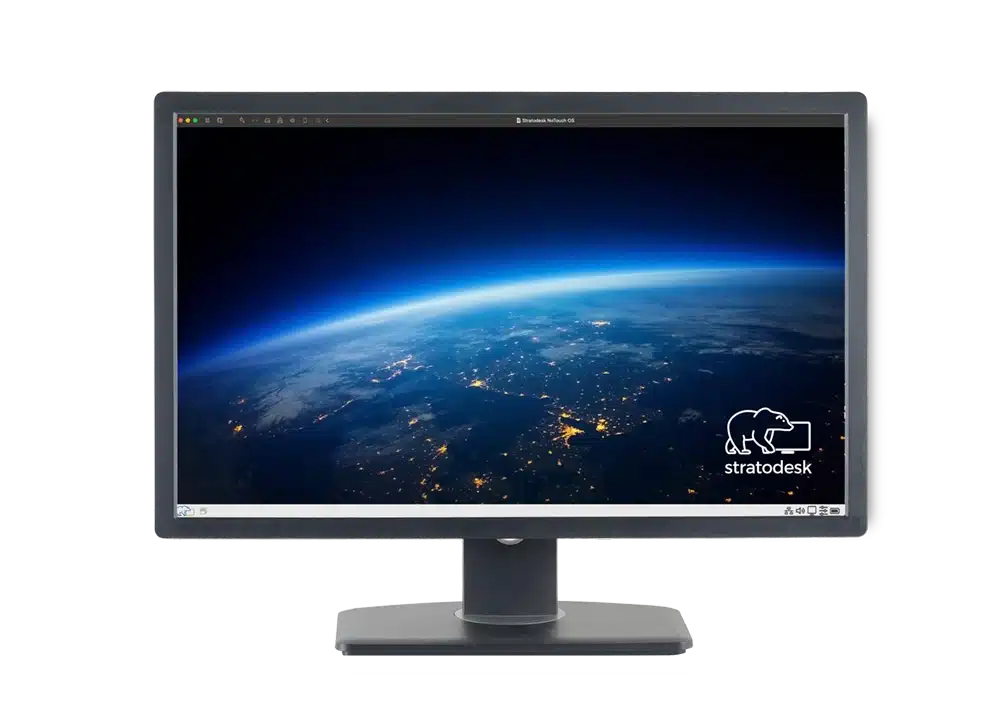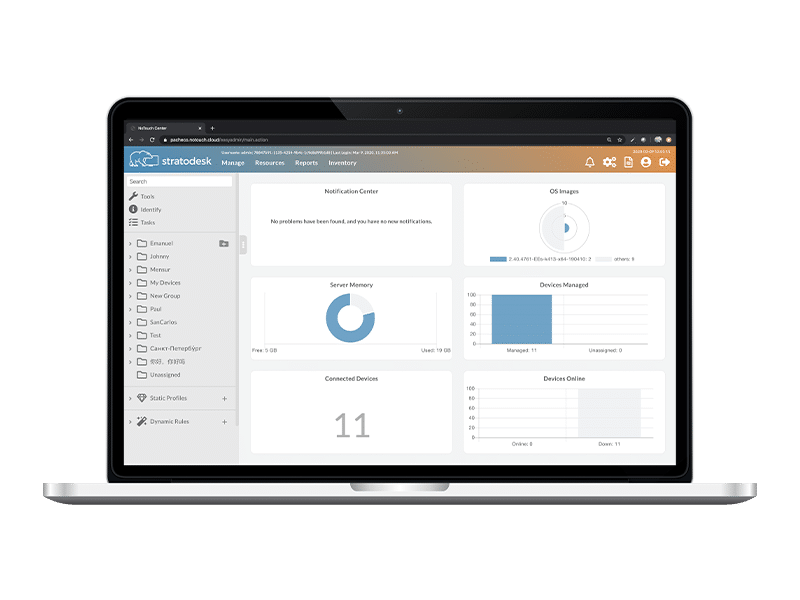October 14, 2025, is less than a year away. This is a red-letter day on all CTOs’ and their subordinates’ calendars as it is the day Windows 10, the backbone of many corporate desktops, reaches its end-of-life (EOL).
Companies, CTOs, and technologists need to start planning for this event, as it will affect all of a company’s employees in one way or another. Directions and strategies must be devised, and budgets must be set far in advance of this event. Proof of concept deployments must be tested, and support must be ramped up months before transitioning from Windows 10. Finally, all employees need to be trained before their Windows 10 desktops are replaced. But the question is, what will they be replaced with?
In the rest of this article, I will discuss companies’ and institutions’ options for replacing Windows 10 desktops and how Stratodesk can provide a secure, reliable, and cost-effective way to assist in modernizing users’ access to their applications.
Background
It is hard to believe that Windows 10 was released about a decade ago (July 2015) and is still, according to statcounter.com, running on about 60% of Windows desktops, making it the most used desktop OS in the world. With its looming EOL, we see an uptake in Windows 11, but adoption is only 35%. With estimates that 400 million PCs still run Windows 10, hundreds of millions of users will be affected when it EOLs.

Windows 11 has been out since 2021 and has been heavily pushed by Microsoft since its release, but the number of people still using it indicates that there will be a lot of transitioning from it in the next year. To “help” with this transition, many people are worried Microsoft may have a forced update to Windows 11 from 10 just as they are forcing patches on some Windows 11 systems. A forced and unplanned update would wreak havoc with companies as they have a carefully curated software stack that may not play nice with a new OS.
As it currently stands, on October 15, 2025, not much will appear to happen to users still running Windows 10; they will not wake up to a computer that will not boot or function any differently than it did the day before. However, an even more hideous thing will happen: Windows 10 will no longer receive security updates, leaving them vulnerable to being compromised. I firmly believe that nefarious forces will be laying in wait and will take advantage of this day to launch an unparalleled onslaught of threats on the millions of systems that will still be running Windows 10.
What To Do
Some companies will choose to upgrade all their preexisting systems to Windows 11, and depending on their licensing model, this may even appear to be free.

However, this strategy has many caveats, as Windows 11 has many hardware requirements, such as only supporting specific CPUs, systems with TPM 2.0 and requires even more disk space than Windows 10.
Anyone who has done a large-scale migration such as this knows that even in the best case, many systems will give you problems that must be addressed. These issues will suck up your support organization’s time.
A Better Way
Forward-thinking companies are looking for alternatives to managing physical desktops, which can be hassle-inducing and time-consuming. They see this as an opportunity to reevaluate their desktop and application delivery strategy to a more modern one where Stratodesk No Touch OS is implemented. This provides a more reliable, secure, and cost-effective solution than physical Windows devices.
To reach this goal, some companies will implement an in-house virtual desktop infrastructure (VDI), while others will go to the public cloud and use a desktop as a service (DaaS) model. Still, others will avoid using desktops altogether by using streaming applications or software-as-a-service (SaaS) to deliver applications. All these options will supply their users with a more secure and robust environment and can provide a lower total cost of ownership (TCO) for companies. The great thing about all these solutions is that they eliminate one of the most significant headaches for IT support: Windows running on physical devices, and even a bigger IT headache: Windows devices running in remote locations.

Let’s examine these technologies more deeply to understand how they work and their advantages over running Windows on a physical desktop.
VDI and DaaS
VDI is a long-proven technology that provides virtual Windows desktops hosted in a company’s data centers or via the public cloud, which users access remotely.
VDI gained much traction when people dealt with the Windows 7/8.1 migration to Windows 10, and it appears that it will do so again with the Windows 10 to 11 migration. Stephen Wagner, internationally renowned EUC expert and President of Digitally Accurate Inc., says that despite dealing with all the new “features” that come with Windows 11, organizations are already seeing significant performance gains by switching to Windows 11 in their VDI environments. He further states that for those who haven’t migrated to VDI, Windows 10 EOL makes it the perfect time to switch to Virtual Desktops as VDI provides flexibility, eases management and maintenance, reduces costs, and enhances security, improving the user experience.
DaaS is becoming popular because VDI requires companies to purchase and administrators to look after the underlying infrastructure. In contrast, DaaS does not, as the hardware infrastructure is maintained, managed, and housed in the public cloud. This frees up the IT support staff to perform more productive tasks.
AWS WorkSpaces and Microsoft Azure Virtual Desktop are two of the more popular DaaS offerings, but many smaller players cater to niche markets such as education, media, and entertainment. It should be noted that many popular VDI solutions, such as Omnissa Horizon, can run on DaaS, which simplifies infrastructure maintenance and has an OpEx financial model.
Many forward-thinking companies have already modernized and are using VDI or DaaS to supply users with Windows virtual desktops. However, they still use Windows 10 devices to access their virtual desktops; these will also reach EOL on October 15th. This is where the flexibility of Stratodesk NoTouch OS comes in. These machines and those being replaced by VDI or DaaS can be converted to run Stratodesk NoTouch OS, making them a more secure, reliable, and cost-effective way for end-users to access their virtual desktops.
Getting Rid of the Desktop Altogether
Desktop OS requires that users and IT administrators constantly patch and update the OS and be vigilant against viruses and other threats that may appear. Many companies have realized that their users don’t need a full desktop; they only need access to applications. By only delivering applications to the end users, they significantly reduce their risk of being compromised and their support costs.
Streaming Applications
Whereas VDI and DaaS present an entire desktop to their users, streaming applications just present applications to them. Many different technologies enable this, with some running on servers in a company’s data center while others run in public clouds.
The screenshot below shows the Horizon client, which allows the user to launch one or more streaming applications, running on a low-cost thin client running Stratodesk NoTouch OS.
SaaS and Enterprise Browsers
One of the newest desktop technologies we see is enterprise browsers, which allow employees to use a web browser enhanced with enterprise features to access Office365, Salesforce, and other SaaS applications.
Many analysts are so bullish on this technology that they have predicted that by 2030, less than five years from now, enterprise browsers will be the core platform for the workforce.
Jason Trunk, Vice President and Field CTO at Island.io, an early innovator in enterprise browsers, said that a well-designed enterprise browser enhances the user experience, strengthens cybersecurity, ensures regulatory compliance, and safeguards data, all while boosting employee productivity.
There is a multitude of reasons enterprise web browsers are garnering so much attention; many companies’ business apps are already SaaS-based, they require little to no employee training, and all leading enterprise browsers run natively on Stratodesk NoTouch OS.
Accessing Remote Desktops and Applications
As mentioned above, whether companies use VDI, DaaS, streaming applications, or enterprise browsers to modernize their workforce and get off Windows 10, they will still need a device to access their desktops or applications, and this is where Stratodesk comes in.

Stratodesk NoTouch OS is an extremely lightweight, cost-efficient, high-performance, and secure OS that allows end-users to access remote applications and desktops.
As NoTouch consumes far fewer resources than a PC running Windows, it can easily run on all those Windows 10 PCs whose hardware is not suitable for Windows 11 while still delivering the end user an exceptional experience. Converting these systems to NoTouch will prevent the estimated 50-60% of Windows 10 PCs that cannot run Windows 11 from ending up in landfills.

Converting a Windows PC to NoTouch is so simple that many end-users can perform it themselves. If IT support is required, or if IT chooses to do the conversion, they will find that it takes a fraction of the time compared to converting a PC to Windows 11. As a bonus, these conversions are so simple that they can be performed by junior-level support staff.

Many companies are pleasantly surprised that if they need new end-point devices, the cost of new thin clients is a fraction of that of new PCs running Windows 11. Devices are available from all the major vendors (HP, Dell, Lenovo, etc.) in various form factors.
Companies will find that modernizing their workforce to thin clients running Stratodesk NoTouch OS will decrease their support costs dramatically, as thin clients are far less complicated to maintain using NoTouch Center.
 If a thin client running Stratodesk NoTouch OS has a hardware issue, it can be replaced with another device without difficulty; the end-user merely plugs their monitor and peripheral devices into another thin client, logs in, and continues their work with minimal disruption.
If a thin client running Stratodesk NoTouch OS has a hardware issue, it can be replaced with another device without difficulty; the end-user merely plugs their monitor and peripheral devices into another thin client, logs in, and continues their work with minimal disruption.
Simplified Support for Virtual Desktops and Applications
If users have issues with their virtual desktops, support will have a far easier time helping them. If their virtual desktop experiences a catastrophic failure, the data center will have an enterprise-grade backup that can be quickly restored.
Those who choose to supply their users with streaming or SaaS apps will also find that their support costs will decrease as SaaS applications are supported by their providers rather than by in-house technicians.
SaaS and streaming applications avoid incompatibility issues often associated with running applications on full desktops, further reducing IT headaches.
The Present is Where you Create Your Future
The coming year will be an exciting and intense time for IT staff. Whether you supply your users with full desktops using VDI or DaaS or allow them to bypass the desktop altogether by using streaming applications or enterprise browsers, Stratodesk can provide you with a cost-efficient, reliable, and highly secure way to deliver applications to your end users.
So, to Windows 10, I say so long, farewell, auf wiedersehen, goodbye. It was a good 10-year run. Sure, there were a few laughs, tears, and more than a few painful viruses, but you grew old in the tooth, and Microsoft decided to put you out to pasture. Now, it is time for us to determine what direction to go. A few will stay the course and still run physical desktops; however, many others will seize this opportunity to modernize their workforce to create more efficient, secure, and robust workplaces for their employees.




